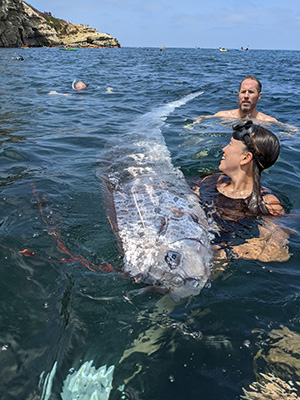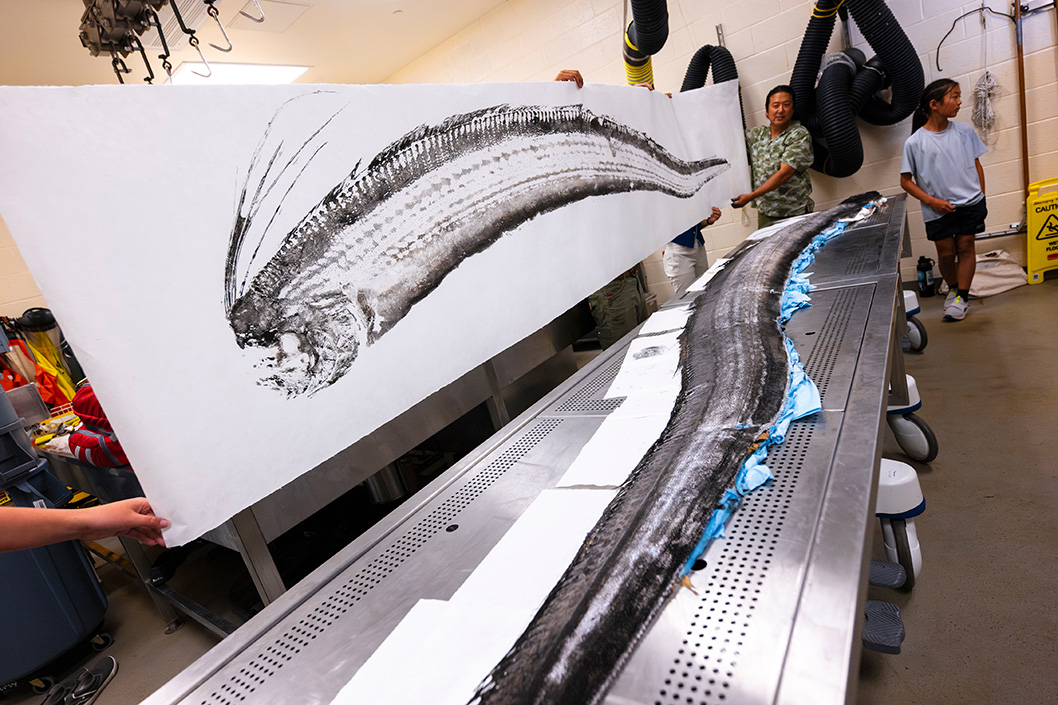Fish Experts Study Rare Deep-Sea Oarfish in the Lab
Following necropsy, scientists learn more about biology of 12-foot oarfish that washed up in La Jolla Cove
Published Date
Story by:
Media contact:
Share This:
Article Content
A team of science-minded kayakers and snorkelers in La Jolla Cove had the encounter of a lifetime when a dead oarfish washed to the ocean surface on Aug.10, 2024. This deep-sea fish is incredibly rare, and marks only the 20th oarfish documented to have washed up in California since 1901.
Thanks to the work from these locals, the fish was transported to the NOAA Fisheries’ Southwest Fisheries Science Center in La Jolla. On Aug. 16, a team of scientists from UC San Diego’s Scripps Institution of Oceanography, California State University Fullerton, and NOAA Fisheries’ Southwest Fisheries Science Center were able to examine the rare short-crested oarfish (Regalecus russellii), performing a necropsy, or animal autopsy, to learn more about this unique organism.

“Rare encounters like this provide an amazing opportunity to learn more about this species and how it lives,” said Ben Frable, ichthyologist and manager of the Marine Vertebrate Collection at Scripps, who was part of the necropsy team. “We are fortunate to have a large community of researchers and world-class collection that mobilized quickly to examine and preserve this fish.”
The fish was an adult male, measuring 12.25 feet (3.735 meters) in length, 1.14 feet in depth (0.348 meters), and weighed 74.3 pounds (33.7 kilograms). This unusual deep-water fish has a scaleless, long ribbon-like silvery body with dark spots. A long red dorsal fin crest, measuring 2.17 feet in length (0.662 meters), extended from the top of the head.
The fish was in good condition and it is not clear why the fish died.
Scientists also do not know why the fish washed up where it did, though it is generally thought to have to do with injury, illness, and disorientation. Frable noted that La Jolla Shores is situated next to two underwater canyons that funnel deep water close to shore. This proximity may contribute to why disoriented or injured deep-sea fish, such as lancetfish and footballfish, occasionally wash up in the area.
Samples were obtained during the examination that will be used to shed light on the little known biology of this oarfish. These samples will be used to:
- Generate the first high-quality, chromosome-level genome for the longest bony fish in the world, providing a foundational reference for future genetic and genomic studies.
- Use stable isotopes and genetic barcoding to better understand foraging ecology, or what the fish is eating and its role in the marine food web.
- Describe the shape and function of the gills and gill rakers — the elements that the fish use to filter their prey from the water — to look at the filtering anatomy and to inform studies of metabolism and feeding strategies.
- Describe the reproductive status. This male did not have visible signs of milt (sperm) and scientists have previously found that oarfish locally are reproducing in June, but not August and September.
- Analyze organs, tissues and body fluids for potential presence of contaminants such as microplastics and DDT.
- Compare the digestive system with the other species of oarfish, Regalecus glesne.
“This finding significantly contributes to documenting life on our planet, with each specimen providing valuable data to guide conservation efforts and enhance our understanding of marine ecosystems. Collections like ours play a crucial role in preserving these specimens for future research, ensuring that we can continue to learn from them for generations to come.”
After the examination, the fish is undergoing preservation and is now part of the Marine Vertebrate Collection at Scripps, which houses one of the largest collections of deep-sea fish in the world.
“This oarfish presents a rare opportunity to obtain fresh samples for genomic analysis, allowing us to study the evolutionary adaptations that enable this species to thrive in deep-sea environments,” said Dahiana Arcila, marine biologist and curator of the Marine Vertebrate Collection at Scripps. “This finding also significantly contributes to documenting life on our planet, with each specimen providing valuable data to guide conservation efforts and enhance our understanding of marine ecosystems. Collections like ours play a crucial role in preserving these specimens for future research, ensuring that we can continue to learn from them for generations to come.”
Often described as sea serpents in history, oarfish can grow to lengths of 30 feet and are the longest bony fish in the world. While oarfish have a mythical reputation as predictors of natural disasters and earthquakes, experts have debunked this as folklore. A 2019 study found no correlation between oarfish or ribbonfish strandings and earthquakes in Japan.

Given the immense local and global interest, Birch Aquarium at Scripps has opened a temporary exhibit with more information on this mysterious fish. The display in the main galleria at Birch Aquarium will include a life-size gyotaku art print of the oarfish done by artist Dwight Hwang after the necropsy was completed.
Each rare specimen that is collected offers researchers a valuable opportunity to gain new insights. If someone finds a unique creature on the beach, they are encouraged to alert the local lifeguards. If in Southern California, members of the public can notify Scripps Institution of Oceanography at scrippsnews@ucsd.edu or (858) 534-3624. It should also be noted that many beaches may be marine protected areas, where taking of organisms is illegal.
Members of the public interested in supporting the research and discoveries of the Scripps oceanographic collections can do so through this fund link.
The team of scientists that performed the necropsy include Arcila and Frable of Scripps Oceanography; Misty Paig-Tran, associate professor of biological sciences, and graduate students Jordyn Neal, Katie Kern, and Jessica Clark from California State University Fullerton; and research fish biologist Nick Wegner and scientist Antonella Preti from NOAA Fisheries’ Southwest Fisheries Science Center.
The individuals who identified the oarfish while kayaking and snorkeling were Emily Miller of California Sea Grant; Natalia Erazo, Alejandro Cano-Lasso Carretero, and Gabriella Costa Machado da Cruz of Scripps Oceanography; Michael Wang, Luis Erazo, Monica DeYoung and Andrew Musbach.
Share This:
You May Also Like
UC San Diego is Strengthening U.S. Semiconductor Innovation and Workforce Development
Technology & EngineeringStay in the Know
Keep up with all the latest from UC San Diego. Subscribe to the newsletter today.




